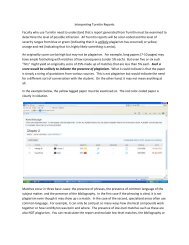The Renaissance Development of the Scientific Illustration - Winthrop
The Renaissance Development of the Scientific Illustration - Winthrop
The Renaissance Development of the Scientific Illustration - Winthrop
You also want an ePaper? Increase the reach of your titles
YUMPU automatically turns print PDFs into web optimized ePapers that Google loves.
hrst inventorsigned appro-<strong>Development</strong> <strong>of</strong> <strong>Scientific</strong> <strong>Illustration</strong>priate machines, and worked out certain bugs apparent in <strong>the</strong> similar designs <strong>of</strong>his predecessors, host entirely through <strong>the</strong> medium <strong>of</strong> drawing. Francesco diGiorgio's example may well have inspired Leonardo da Vinci, who owned andannotated one <strong>of</strong> <strong>the</strong> Sienese artisan-engineer's manuscripts."Let us analyze one such design in <strong>the</strong> Trattato example. In <strong>the</strong> lower righthandcorner <strong>of</strong> <strong>the</strong> illustration, we see Francesco di Giorgio's representation <strong>of</strong>a reciprocal suction pump after Taccola. In <strong>the</strong> original Taccola design (seeillustration above), we note that <strong>the</strong> piston is attached to <strong>the</strong> crank by only arope. This is because Taccola realized that <strong>the</strong> crank makes a rotary motion as itraises and lowers <strong>the</strong> piston, and this must naturally cause whatever connects<strong>the</strong> crank to <strong>the</strong> piston to oscillate. Since a rope is flexible, Taccola thought touse it instead <strong>of</strong> a more stable connecting rod which might unduly force <strong>the</strong>piston to bind against <strong>the</strong> cylinder sidewalls. Francesco di Giorgio, on <strong>the</strong>o<strong>the</strong>r hand, apparently felt that Taccola's pump was still inefficient so hecompensated for <strong>the</strong> rotary motion <strong>of</strong> his crank by designing a solid connectingrod with a loop. A hollow roller was to be placed around <strong>the</strong> connecting arm <strong>of</strong><strong>the</strong> crank which <strong>the</strong>n slipped inside <strong>the</strong> loop. This would allow <strong>the</strong> connectingrod to move up and down without oscillation and without decreasing <strong>the</strong>pump's efficiency through unnecessary friction.Francesco di Giorgio's machine-drawing conventions, derived and modifiedfrom Taccola, were much disseminated and copied during <strong>the</strong> late fifteenth andsixteenth centuries. Art historian Gustina Scaglia has examined dozens <strong>of</strong>manuscript notebooks from <strong>the</strong> period which attest to his widespread influence.Science historian Ladislao Reti has traced this influence on <strong>the</strong> printed"<strong>the</strong>ater <strong>of</strong> machines" literature <strong>of</strong> <strong>the</strong> sixteenth, seventeenth, eighteenth, andeven nineteenth centuries." Since Leonardo da Vinci also had access toFrancesco di Giorgio, it may well be true that his own scientific drawings, <strong>the</strong>most beautiful as well as informative pictorial documents on science ever seenup to <strong>the</strong> sixteenth century, owed to this revived artisan-engineer traditionwhich began in quattrocento Siena with Taccola. In a remarkable article on <strong>the</strong>fifteenth-century notion <strong>of</strong> "genius" and "invention," art historian MartinKemp has shown that until <strong>the</strong> time <strong>of</strong> Leonardo, <strong>the</strong> word ingegno was rarelyapplied to makers <strong>of</strong> pictures. To earn that accolade, as did Brunelleschi in hisepitaph, one had to be an architect or builder <strong>of</strong> actual machines. Toward <strong>the</strong>end <strong>of</strong> <strong>the</strong> century, however, <strong>the</strong> word ingegno begins to be associated withpainters. This was clearly a tribute to <strong>the</strong>ir ability, as with Francesco di Giorgioand Leonardo, to draw pictures from which actual buildings and machinescould <strong>the</strong>n be constructed.16Yet it is a sad fact that nei<strong>the</strong>r Leonardo's nor Francesco di Giorgio's manuscriptswere ever set to type in <strong>the</strong> new printing press. <strong>The</strong>ir revolutionaryillustrations were never published over <strong>the</strong>ir own names until centuries later.Leonardo's drawings showed special ingenuity in <strong>the</strong> application <strong>of</strong> "exploded,"'rotated," and "transparent" or 'cutaway views," and he was also <strong>the</strong>first artisan-engineer to apply <strong>the</strong>se postlinear perspective conventions to <strong>the</strong>representation <strong>of</strong> anatomical details. Leonardo himself was not resistant to












